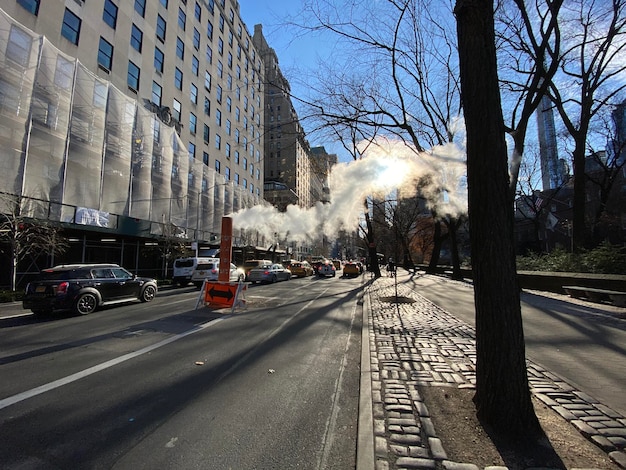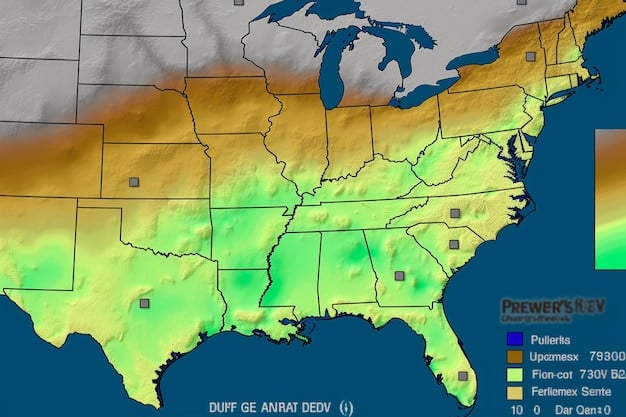Air Pollution in the US: New Study Links to Respiratory Illnesses

New research has established a significant link between air pollution levels in the US and the prevalence of respiratory illnesses, highlighting the urgent need for improved air quality standards and public health interventions.
Recent findings have shed light on the detrimental effects of air pollution, revealing a concerning link between exposure and the increased incidence of respiratory illnesses in the US. This new research underscores the necessity for greater awareness and proactive measures to mitigate the impact of air pollution on public health.
Understanding the Scope of Air Pollution in the US
Air pollution in the United States is a multifaceted issue, stemming from various sources and affecting different regions in unique ways. Understanding the breadth and depth of this problem is the first step toward addressing its health consequences. This section will explore the primary sources and regional variations of air pollution across the country.
The sources of air pollution are diverse, ranging from industrial emissions to vehicular exhaust and agricultural activities. Each source contributes a unique set of pollutants that can impact respiratory health.
Major Sources of Air Pollution
- Industrial Emissions: Factories and manufacturing plants release a variety of pollutants, including particulate matter, sulfur dioxide, and nitrogen oxides, which can irritate the respiratory system.
- Vehicular Exhaust: Cars, trucks, and buses emit pollutants like carbon monoxide, nitrogen oxides, and volatile organic compounds, contributing significantly to urban air pollution.
- Agricultural Activities: Farming practices can release ammonia and other pollutants into the air, leading to the formation of harmful particulate matter.

Regional Variations in Air Quality
Air quality varies significantly across the United States, with some regions experiencing higher levels of pollution than others. Factors such as population density, industrial activity, and geographical conditions all play a role.
- Urban Centers: Major cities often suffer from high levels of vehicular and industrial pollution, leading to respiratory issues like asthma and bronchitis.
- Rural Areas: Agricultural regions may experience air pollution from farming activities and pesticide use, affecting the respiratory health of residents.
- Coastal Regions: Areas near the coast can be affected by pollutants from shipping and offshore drilling, in addition to local sources of pollution.
By understanding the various sources and regional variations of air pollution, we can better appreciate the complexities of addressing this issue and protecting public health.
Respiratory Illnesses Linked to Air Pollution
Air pollution has long been associated with a range of respiratory illnesses, and new research continues to strengthen this link. This section will delve into the specific respiratory conditions that are most commonly exacerbated or caused by exposure to air pollutants. By understanding these health impacts, we can better appreciate the importance of reducing air pollution levels.
Air pollution can affect the respiratory system in various ways, leading to both acute and chronic conditions.
Common Respiratory Illnesses
Several respiratory conditions are known to be linked to air pollution, each with its own set of symptoms and health consequences.
- Asthma: Air pollution can trigger asthma attacks and worsen symptoms, especially in children and the elderly.
- Chronic Bronchitis: Long-term exposure to air pollution can lead to chronic inflammation of the bronchial tubes, causing persistent coughing and difficulty breathing.
- Emphysema: Particulate matter and other pollutants can damage the air sacs in the lungs, leading to emphysema and reduced lung function.
Impact on Vulnerable Populations
Certain populations are more vulnerable to the respiratory effects of air pollution, including children, the elderly, and individuals with pre-existing respiratory conditions.
- Children: Their lungs are still developing, making them more susceptible to damage from air pollutants.
- Elderly: Their immune systems are often weaker, making them less able to fight off respiratory infections caused by air pollution.
- Individuals with Pre-existing Conditions: Those with asthma, COPD, or other respiratory illnesses are more likely to experience exacerbated symptoms when exposed to air pollution.
Understanding the specific respiratory illnesses linked to air pollution and the populations most at risk is crucial for developing targeted interventions and protecting public health.

Key Findings from Recent Research
Recent studies have provided valuable insights into the link between air pollution and respiratory illnesses in the US. This section will summarize the key findings from this new research, highlighting the specific pollutants of concern, the regions most affected, and the magnitude of the health impacts.
New research is continually revealing the extent of the relationship between air pollution and respiratory health.
Specific Pollutants of Concern
While many pollutants contribute to air pollution, some have been identified as particularly harmful to the respiratory system.
- Particulate Matter (PM2.5): Fine particles that can penetrate deep into the lungs, causing inflammation and increasing the risk of respiratory illnesses.
- Ozone (O3): A gas formed from the reaction of pollutants in sunlight, which can irritate the airways and trigger asthma attacks.
- Nitrogen Dioxide (NO2): A gas emitted from vehicles and industrial sources, which can exacerbate respiratory conditions and increase susceptibility to infections.
Regional Hotspots of Air Pollution
Certain regions in the US have been identified as hotspots for air pollution, where the levels of pollutants are consistently higher than the national average.
- California’s Central Valley: Agricultural activities and vehicle emissions contribute to high levels of particulate matter and ozone.
- The Ohio River Valley: Industrial activity and coal-fired power plants release pollutants that affect respiratory health.
- Major Metropolitan Areas: Cities like New York, Los Angeles, and Chicago often experience high levels of vehicular and industrial pollution.
The new research emphasizes the need to focus on specific pollutants and regions to effectively mitigate the health impacts of air pollution.
Policy and Regulatory Measures
Addressing the issue of air pollution and its impact on respiratory illnesses requires a combination of policy and regulatory measures. This section will explore the current regulations in place in the US, as well as potential policy changes that could further reduce air pollution levels and protect public health.
Effective policies and regulations are essential for reducing air pollution and safeguarding public health.
Current Regulations in the US
The US has a number of regulations aimed at controlling air pollution, including the Clean Air Act, which sets standards for various pollutants.
- Clean Air Act: Establishes National Ambient Air Quality Standards (NAAQS) for pollutants like ozone, particulate matter, and carbon monoxide.
- Emission Standards for Vehicles: Regulates the emissions from cars, trucks, and other vehicles to reduce air pollution.
- Industrial Regulations: Sets limits on the amount of pollutants that industrial facilities can release into the air.
Potential Policy Changes
Despite the existing regulations, there is still room for improvement in reducing air pollution levels. Potential policy changes could include stricter emission standards and increased investment in clean energy.
- Stricter Emission Standards: Implementing more stringent emission standards for vehicles and industrial facilities could significantly reduce air pollution.
- Investment in Clean Energy: Promoting the use of renewable energy sources like solar and wind power could reduce reliance on fossil fuels and lower air pollution levels.
- Public Transportation Improvements: Enhancing public transportation systems could encourage people to drive less, reducing vehicular emissions.
By strengthening existing regulations and implementing new policies, the US can make significant strides in reducing air pollution and protecting the respiratory health of its citizens.
Individual Actions to Reduce Air Pollution
While policy and regulatory measures are essential, individual actions can also play a significant role in reducing air pollution. This section will explore practical steps that individuals can take to minimize their contribution to air pollution and protect their respiratory health.
Every individual can make a difference in reducing air pollution.
Simple Steps for Reducing Pollution
Many simple actions can help reduce air pollution, from driving less to conserving energy.
- Use Public Transportation: Opt for buses, trains, or bicycles instead of driving whenever possible to reduce vehicular emissions.
- Conserve Energy: Turn off lights and appliances when not in use, and use energy-efficient appliances to reduce the demand for fossil fuel-based power.
- Plant Trees: Trees absorb air pollutants and release oxygen, helping to improve air quality.
Protecting Your Respiratory Health
In addition to reducing air pollution, individuals can take steps to protect their respiratory health when air quality is poor.
- Monitor Air Quality Reports: Stay informed about air quality conditions in your area and avoid outdoor activities when air pollution levels are high.
- Use Air Purifiers: Install air purifiers in your home to remove pollutants from the indoor air.
- Wear a Mask: When air pollution levels are high, wear a mask when outdoors to filter out particulate matter and other pollutants.
By taking these individual actions, people can contribute to cleaner air and protect their respiratory health.
Future Directions in Air Pollution Research
The field of air pollution research is constantly evolving, with new studies providing deeper insights into the complex interplay between air pollution and respiratory illnesses. This section will explore the emerging areas of research that hold promise for improving our understanding of air pollution‘s health impacts and developing more effective interventions.
The future of air pollution research holds great potential for advancing public health.
Emerging Research Areas
Several emerging research areas are poised to make significant contributions to our understanding of air pollution.
- Long-Term Health Effects: Studies are needed to better understand the long-term health effects of chronic exposure to low levels of air pollution.
- Personal Exposure Monitoring: Developing more accurate methods for measuring personal exposure to air pollution can help identify individuals at high risk.
- Intervention Strategies: Research is needed to evaluate the effectiveness of different intervention strategies for reducing air pollution and protecting public health.
By continuing to invest in air pollution research, we can develop more effective strategies for mitigating its impact on respiratory health and ensuring a cleaner, healthier future for all.
| Key Point | Brief Description |
|---|---|
| 💨 Air Pollution Sources | Includes industrial emissions, vehicular exhaust, and agricultural activities. |
| 🫁 Respiratory Illnesses | Common conditions include asthma, chronic bronchitis, and emphysema. |
| 🛡️ Regulations | Clean Air Act and emission standards aim to control pollution. |
| 🌳 Individual Actions | Using public transit, conserving energy, and planting trees help. |
Frequently Asked Questions
▼
The primary sources include industrial emissions, vehicular exhaust, agricultural activities, and power generation, each releasing different pollutants into the air.
▼
Exposure to polluted air has been linked to asthma, chronic bronchitis, emphysema, and other respiratory infections, particularly in vulnerable populations.
▼
Individuals can use public transportation, conserve energy, plant trees, and reduce their consumption of goods that contribute to pollution.
▼
Children are more susceptible to the effects of air pollution because their lungs are still developing, leading to increased risk of respiratory issues.
▼
The Clean Air Act sets standards for pollutants, while emission standards regulate vehicles and industrial facilities to control air pollution levels.
Conclusion
The compelling evidence from new research solidifies the link between air pollution and respiratory illnesses across the US, highlighting the need for comprehensive strategies to reduce emissions, protect vulnerable populations, and promote a healthier environment for all.





